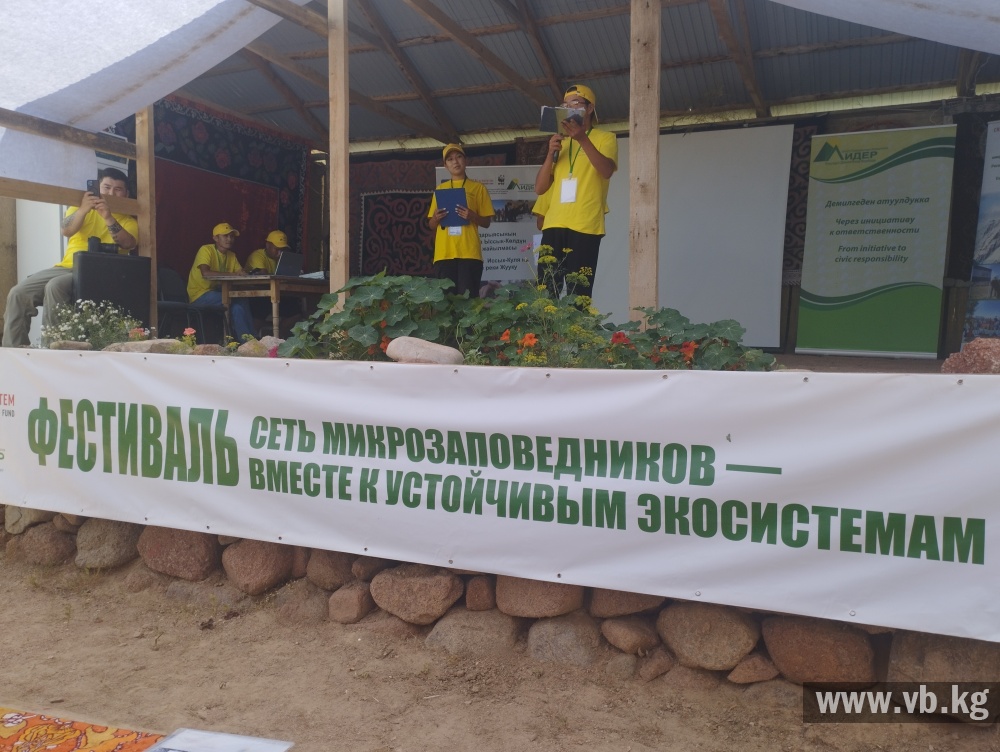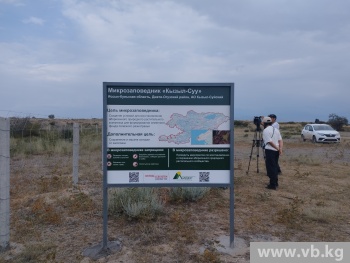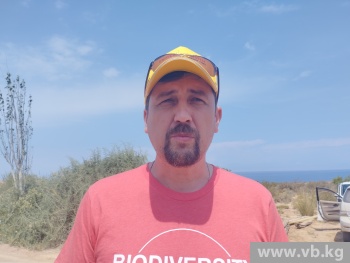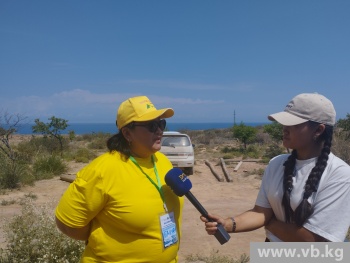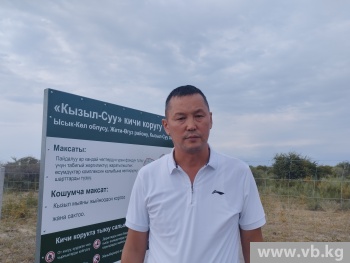Photo: Nazgul Abdyrazakova
Journalists visited the Kyzyl-Suu micro-reserve, located in the Jeti-Oguz district of the Issyk-Kul region. It was created thanks to the project “Expanding the concept of micro-reserves in the regions of Kyrgyzstan”, implemented by the Central Asian State Nature Center “Leader” within the framework of the Central Asian program for the conservation of rare animals and unique natural areas.
In total, 5 micro-reserves were created within the framework of the project – Kara-Koyun, Ozgorush Aigulu, Kulupbek, Salaa-Tash and Kyzyl-Suu, which successfully passed all stages of registration in accordance with the decree of the Cabinet of Ministers, which approved the procedure for the formation and functioning of micro-reserves and specially protected natural areas of local significance (SPNA).
The Kyzyl-Suu micro-reserve itself is located at an altitude of 1,609 meters above sea level and covers an area of 10 hectares. Important species of shrubs grow here, such as sea buckthorn, barberry, rose hips and caragana, which play a key role in cleaning water and soil.
According to Mikhail Yakovlev, country coordinator of the Key Biodiversity Areas Conservation Program in Central Asia, the project to promote micro-reserves significantly contributes to the conservation of ecosystems.
“I am familiar with the history of the micro-reserve concept developed by our famous scientist Emil Dzhaparovich Shukurov. Banur Abdievna took this concept and began to create ecosystem restoration zones with the help of local communities. As a result, five pilot micro-reserves were created. This is a very interesting experience for us, since we have long dreamed of local communities being able to preserve areas important to them. Not only is state management of large natural parks and reserves important, but also the creation of micro-reserves, which can significantly contribute to the preservation of ecosystems. At the festival, we discuss the experience gained from the project. Other organizations involved in the creation of reserves and micro-reserves have arrived. This festival is an excellent platform for establishing new connections and partnerships. Our program will end someday, but the opportunity provided to local communities to create the ecosystems they need is of great importance. I hope that the experience gained within the framework of this project will be spread throughout Central Asia. The micro-reserve concept is unique to Central Asia. Last year, our government passed a resolution allowing the creation of micro-reserves, which is new for the region. We are pioneers in this area, and I hope that this initiative will be supported in other countries, including Uzbekistan, Tajikistan and Kazakhstan,” he told vb.kg.
In turn, the project coordinator with the support of the Critical Ecosystem Foundation, Banur Abdieva, in a conversation with a vb.kg correspondent , expressed confidence that the creation of micro-reserves will, first of all, help prevent natural disasters.
“Our project is called “Expanding the concept of micro-reserves in Kyrgyzstan and Central Asia”. Today we gathered at the festival in Manjyl-Ata, a sacred place, to discuss the importance of preserving biodiversity at the planetary level and the role of Kyrgyzstan in this process. We have preserved hotspots of biodiversity, and we must actively work to preserve and expand them.
At the moment, we have five micro-reserves located in the following areas: Bakai-Ata (Talas region), Kara-Kulja (Osh region), Ala-Buka (Jalal-Abad region), Leilek (Batken region), Kyzyl-Suu (Issyk-Kul region). These pilot projects have completed all eight steps established by the resolution and are awaiting the legal status of micro-reserves.
Today, as part of the festival, participants will present the results of their work, talk about what they have already managed to do and what plans they have.
We also have old micro-reserves that are not yet registered but function as micro-reserves. We work with scientists, practitioners, the state and donor agencies,” she noted.
Tell us about the balances, 60-30, to what extent are they observed?
This is the theory of biotic regulation. There are no exact statistics, but we strive to maintain balance. The theory says that 60% of untouched wilderness should be preserved to maintain normal levels of air and moisture, prevent abnormal heat or cold. 30% should be allocated for agriculture to ensure food security, and 10% for habitation. A simple example is the Sahara Desert, which was formed due to deforestation, which led to a decrease in moisture and the formation of a desert.
What can be done to prevent floods and other natural disasters?
The creation of micro-reserves is the first step to preventing such problems. For example, floodplain forests play an important role in strengthening river banks and preventing mudflows. Recent events show that it is important to carefully develop areas on river banks where shrubs and floodplain forests provide natural fortification.
Such micro-reserves will also help local communities solve the problem of land degradation. This point of view was expressed to vb.kg by the director of the municipal enterprise “Kyzyl-Suu Tazalyk” of the Ton district of the Issyk-Kul region and the director of the micro-reserve “Kyzyl-Suu” Rysbek Kenenbaev.
“We created this reserve to preserve biodiversity, as my work is closely related to ecology. We were faced with the problem of degradation of pasture lands and therefore developed a project that was approved by our local kenesh. We were allocated 3 hectares of land. Thanks to this project, we were able to fence the territory of the reserve and will now monitor its condition for three years. Previously, cattle grazed on this territory, which prevented plants from throwing out their seeds. Currently, wild plants such as barberry, sea buckthorn, licorice and ephedra grow here, and hares and pheasants also live here.
In 2023, we created an eco-fund, which amounted to 300 thousand soms, and in 2024 we plan to add another 300 thousand. If everything goes according to plan, we hope to expand the territory of the reserve. To protect it, we will work with local shepherds and the population, and an environmental police will also function,” he said.
“Today we have completed almost the last step of the eight-stage program and are ready to create a network of micro-reserves. Although the area of the current five micro-reserves is only 19 hectares, we hope to increase this figure in the future. There are already requests from regions for assistance in creating new reserves in order to preserve not only the ecological but also the archaeological heritage.
The criteria for creating micro-reserves include proximity to key biodiversity areas and the presence of rare species of flora and fauna. I am glad that four out of five reserves are the result of many years of work. In the future, we plan to conduct educational events in schools and work with local residents to raise awareness of the value of nature conservation,” added Gamal Sooronkulov, regional director of the EcoMiR public foundation, in a conversation with vb.kg.
https://www.vb.kg/doc/438756_novyy_mikrozapovednik_kyzyl_syy:_iniciativa_dlia_zashity_prirody_i_naslediia.html


